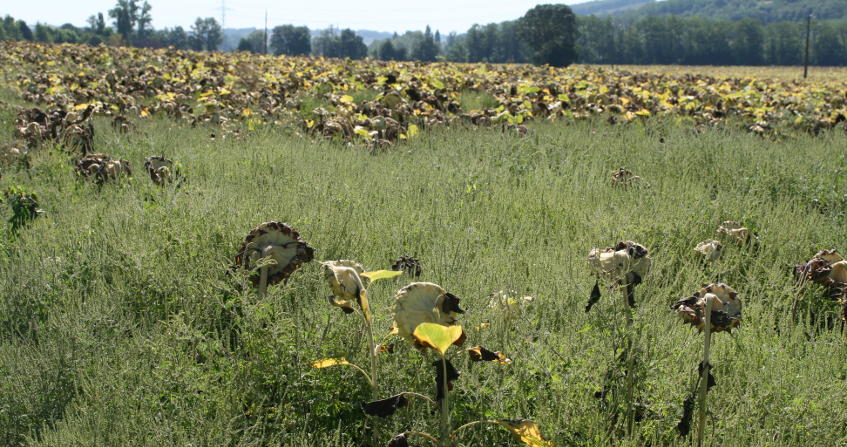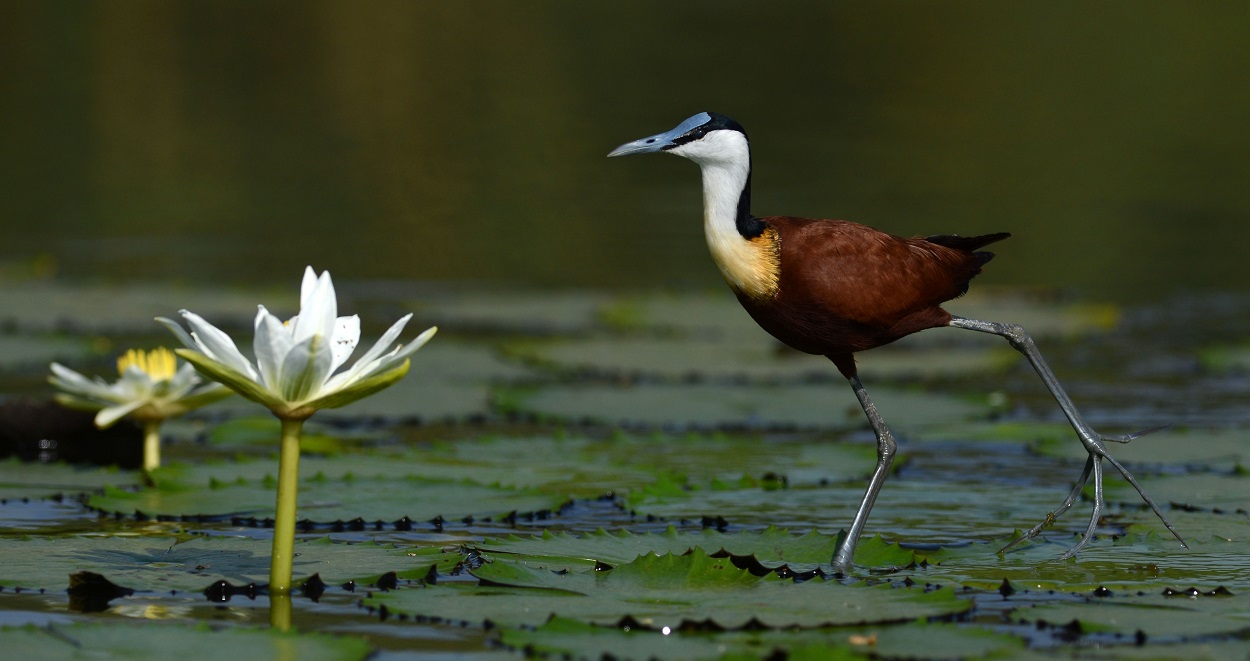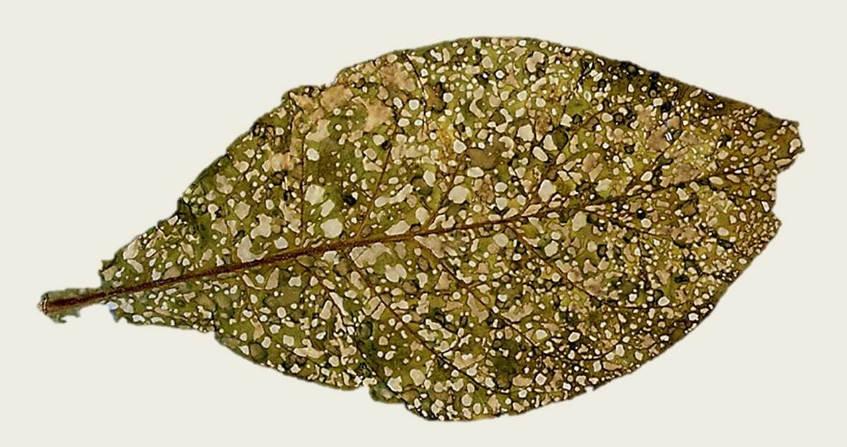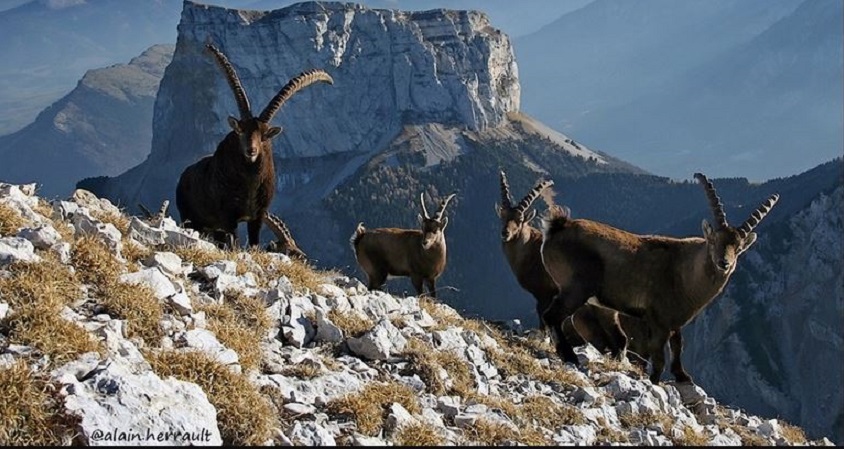When invasive plants also wander in the fields
PDF
Biological invasions are easily perceived by the general public, who see the development of populations of exotic animals or plants on roadsides, ponds or urban wastelands… The expansion dynamics of these species could be a cause for satisfaction in the global context of reduced diversity if biological invasions were not themselves one of the causes of the disappearance or, at least, drastic reduction of animal and plant diversity. The problem of invasive plants concerns all environments, especially those used for agriculture. In fact, agriculture is both the cause (voluntary or involuntary) of many introductions and one of the main victims. Invasive species cause yield losses that farmers can respond to by increasing the use of herbicides, which is an environmental issue. Finally, some species such as common ragweed can cause very significant allergy problems for human populations. Only preventive management seems to allow a certain level of efficiency and some regulation of invasive species populations at a level where they could blend into the local flora. Epidemiological surveillance networks have been set up in France to anticipate such biological invasions.
1. Plants that are moving
Mosquito tiger, Asian hornet, Florida turtle, coypu, ragweeds or even primates, the list of species that proliferate with which we are confronted has grown steadily since the beginning of the 20th century. These species are referred to as “invasive” when they have been introduced (voluntarily or accidentally) by humans outside their natural range and their spread threatens biodiversity, the economy and/or human health.
Of the 6,000 vascular plant species recorded today in France, more than 20% are considered non-indigenous, but only slightly more than a hundred have proliferating behaviour, at least locally. Many texts attempt to regulate or organize the fight against these species. The latest European Regulation 1143/2014 [1] on the management of the introduction and spread of invasive species sets out rules to prevent, minimise and mitigate the adverse effects on biodiversity of the introduction and spread of these species within the European Union.

To better understand these phenomena, much theoretical and practical work on these changes in plant range has been carried out in ecology since the late 1950s. These studies involve researchers from different disciplines ranging from health to ecology. The effects of climate change, which can accelerate the progression of some of these plant species, are extensively studied and modelled in order to better anticipate potential new introductions and future expansions.
2. More species but also more problems
One of the major concerns related to biological invasions is a decrease in the diversity of local plant species [3]. Many studies focus on the negative effects of invasive plant species on fragile ecological environments in which endemic species may be endangered by more competitive or allelopathic invasive species (emission of compounds toxic to other plants). Other invasive species can also modify the initial environment: excessive water consumption, modification of organic matter degradation. These transforming species make it difficult to restore [4] the environment, as the initial flora can only be re-established with difficulty due to changes in soil characteristics.
The phenomenon of biological invasions is closely linked to trade globalization. Specialists take as a key date the discovery of the New World (end of the 15th century) to locate the introduction of a new wave of plants such as the species of the genus Amaranthus, now very common in cultivated plots. Introduced voluntarily for aesthetic reasons, such as for the butterfly-bush (Buddleja davidii Franch.), or in botanical gardens (species of the genus Erigeron), some of these species are now part of the common flora such as the common field speedwell (Veronica persica Poir.).
With the development of modern means of transport and globalization, the arrival of new plant species accelerated throughout the 19th and 20th centuries. Humanized and disturbed environments such as harbours, stations, roads, gravel pits or brownfields are habitats colonized by invasive alien plants. While these environments may appear to be particularly “difficult” from an ecological point of view (soils that are more or less artificial and poor in nutrients or polluted with water stresses accentuated by limited water reserves), invasive plants settle there very regularly for two reasons:
- a high frequency of introductions and movement of commodities into these human habitats, which mathematically increases the chances that an individual accidentally introduced with these commodities will find the right conditions for settlement.
- the low intensity of competition from plants that do not constitute sufficiently dense, important and settled communities to prevent the development of newcomers.
Thus, habitat degradation, linked to human activities that can lead to a weakening of local plant and animal communities, promotes the development of invasive species.
3. Why in the fields?
The problem of invasive alien plants also affects cultivated environments [5] which constitute unique ecosystems due to the selection pressures exerted there.
3.1. Favourable farming practices
Various farming practices carried out by farmers are involved:
- environmental disturbance due to tillage and mechanical weeding;
- chemical or thermal weeding practices;
- preferential installation of a cultivated plant sown at optimal densities for its yield.
These practices create an environment in which a limited number of species can survive. Selection pressures are therefore both strong and frequent, but are also variable in space and time due to the crop rotation that takes place there.

At the beginning of their development, annual crops cover only a small area of the soil, allowing the natural flora of cultivated areas (commonly called weeds or weed flora) to develop. This low coverage capacity was compensated by the farmer either by chemical weeding with herbicides applied when the crop emerged, or by early mechanical weeding practices or by installing a living or dead vegetation cover between rows.
However, these practices are not sufficient to limit the presence of weed flora. Invasive species generally have particularly important developmental capacities that are linked to different factors: particular biological characteristics, low effectiveness of weeding practices or lack of biological regulation by predators or parasites. It is observed that spring and summer crops host more invasive species than winter crops. These observations can be explained by the biology of invasive species: many of these exotic species (cocklebur, amaranth …) ) come from different continents (Asia, Africa, America) and are summer plants that are particularly well adapted to crops such as corn. However, if the species does not meet favourable ecological conditions, its development may remain very limited, as is currently the case with Abultilon theophrasti (originating from Asia) in France [6].
3.2. Special biological characteristics

- it seems that large size (competition for light), vigorous vegetative growth, early and prolonged flowering are regularly observed in some of these species.
- invasive species produce a significant number of seeds, more than 1000 seeds per plant for a common ragweed. This does not distinguish them particularly from other weeds that can produce much more (more than 20,000 per plant for a common poppy – Papaver rhoeas). But invasive species are characterized by the duration of seed survival in the soil (Figure 3), which allows them to build up large seed stocks for long-term survival of up to ten years.
The success of invasive plants in crops could be partly due to the occupation of a still vacant ecological niche [7], as European native species are mainly winter germinating species. In addition, by comparing the frequency of American species in crops, only 3% of these invasive species are found in winter cereals, 27% in summer crops (corn or sorghum), while vines and orchards contain about 50%. The establishment of these species in cultivated environments would therefore be more related to the occupation of environments with low plant competition than to biological invasion with the risk of loss of diversity. However, for the farmer, this is a new and sometimes important problem to manage.
3.3. Herbicide-resistant plants
However, some of the problematic invasive weeds observed today in cultivated areas are plants such as bachelor’s button (Cyanus segetum Hill) or common corn-cockle (Agrostemma githago L.) introduced during the Neolithic period with the first crops (so-called archaeophyte plants). The sudden geographical spread of these plant species is generally due to changes in farming practices that have hitherto constituted a lethal selection pressure, or new environmental conditions that are particularly favourable to them (reduced tillage). The development of grassy weed populations (wild oats, ryegrass, blackgrass) in the middle of the last century would have benefited from the use of the first herbicides that only destroyed broadleaf species.


3.4. Common ragweed: agricultural and public health problems
Among the invasive species on cultivated plots, common ragweed (Ambrosia artemisiifolia L.) is one of the plants that can hardly escape the term “weed”. This annual Asteraceae, native to the North American continent, is one of the higher plants to be subject to mandatory destruction decrees in France [8] and it is among the 100 most problematic species in the DAISIE database [9],[10].


In fact, several invasive species in cultivated fields can also pose a potential threat to the environment: the knotgrass (Paspalum distichum L.) and the star cucumber (Sicyos angulata L.) help reduce diversity in riverside forests and wetlands.
In some cases, the cultivated ecosystem may only have an important role at the stages of introduction and spread of a given species, while the most important negative effects may concern, for example, a public health problem or additional costs of roadside management.
3.5. Other species to be monitored in crops
Other species that are less publicized because they do not pose health problems should be closely monitored in the crops:
- The American pokeweed (Phytolacca americana) was introduced at the beginning of the 18th century for ornamentation and especially for its use to colour low quality red wines with its berries. In the Landes region, maize crops, grown from the clearing of pine forests where American grapes were already present in the soil seed bank, are now particularly invasive.
- While the Cyperaceae family is not very common in temperate cultivated environments, the edible nutsedge (Cyperus esculentus leptostachyus) is a plant that has cosmopolitan weed status. This species arrived in southwestern France and Sologne with flower bulbs from the United States and the Netherlands in the 1980s and is developing very rapidly and is a difficult to control weed species [15].
- Finally, the silverleaf nightshade Solanum elaeagnifolium, a Solanaceae of North American origin, has become such a formidable weed in the Maghreb that its presence in southern France has led to immediate eradication actions [16] for fear that this species may become established in France.
4. Effects in cultivated environments that remain to be studied
Invasive plant species in cultivated areas, while they can cause yield losses and real agronomic problems, do not generally pose direct environmental problems. Indeed, the selection pressures exerted by cultural practices on plant communities appear to be more intense than those exerted by the presence of invasive plants. But their presence still requires intensive control that can be harmful to the environment and other species on the cultivated plots, particularly certain species that are already very rare and dependent on crops. Their management problem is no different from that of a ‘local’ weed, but their biological characteristics may require additional weeding interventions (mowing, use of a herbicide). Biological control, which is very poorly developed in conventional weed species, could be solutions to be developed, but they are complex systems that require a thorough knowledge of the biology and biological interactions between the different species concerned [17].
Currently, the effects of climate change on temperatures and precipitation patterns are expected to accelerate the recovery and establishment of new species from the Mediterranean. A number of climatic barriers (disappearance of early frosts in autumn, period of water stress in spring) will directly favour invasive species by allowing a given species to produce seeds or indirectly by limiting competition from native plants. If there are no general management rules, reducing the use of synthetic herbicides will probably require preventive actions depending on the biology of each species, to prevent the development of species before the establishment of large seed stocks in the soil, which then make management options very limited.
References and notes
Cover image. Plot of sunflower invaded by common ragweed (Ambrosia artemisiifolia L.). The crop has completely disappeared in some areas due to the invasive plant. [Source: © Alain Rodriguez – Acta]
[1] http://eur-lex.europa.eu/legal-content/FR/TXT/PDF/?uri=OJ:JOL_2014_317_R_0003&
[2] Merceron M. 1999. Marées vertes en Bretagne : état actuel des connaissances. Colloque ” Pollutions diffuses : du bassin versant au littoral “, Ploufragan, 23-24 September 1999. 49-60. (in french)
[3] Gurevitch J., Padilla D. K. 2004. Are invasive species a major cause of extinctions? Trends in Ecology and Evolution, 19, 9, 470-474.
[4] Conser C., Connor E.F. 2009. Assessing the residual effects of Carpobrotus edulis invasion, implications for restoration. Biological Invasions, 11, 349-358. DOI 10.1007/s10530-008-008-9252-z
[5] Chauvel B., Fried G. 2009. Dans la jungle des milieux cultivés. Dossier Pour la Science, Numéro spécial Invasions Biologiques, 65 – La conquête des espèces, 32-37. (in french)
[6] Chauvel B., Rodriguez A., Fried G. 2017. Focus sur une espèce : Abutilon theophrasti, pas encore la fibre pour s’installer en France ? Journal de Botanique de la Société Botanique de France, 77, 41-48. http://ecophytopic.fr/sites/default/files/JB77-41a48.compressed.pdf (in french)
[7] Mallet, J., Lopez-Garcia, C. 2000. What criteria are relevant for predicting the invasive capacity of a new agricultural weed? The case of invasive species in France. Weed Research, 40, 11-26.
[8] https://www.legifrance.gouv.fr/affichTexte.do?cidTexte=JORFTEXT00000034503018&dateText=&categoryLink=id
[9] http://www.europe-aliens.org/speciesFactsheet.do?speciesId=21692
[10] Only a few native plants, including field waxwort (Cirsium arvense (L.) Scop.), cuscutes (Cuscuta spp.) and orobanches (Orobancha ssp.) can be subject to compulsory control in France.
[11] Ragweed pollen causes allergic reactions in many people: 6 to 12% of the population is sensitive to ragweed. It only takes 5 grains of pollen per cubic metre of air for symptoms to appear.
[12] Chauvel B., Dessaint F., Cardinal-Legrand C., Bretagnolle F. 2006. The historical spread of Ambrosia artemisiifolia L. in France from herbarium records. Journal of Biogeography, 33, 665-673.
[13] http://agriculture.gouv.fr/intoxications-alimentaires-liees-la-consommation-de-farine-de-sarrasin
[14] Chamber of Agriculture Lozère, 2013
[15] Bohren C., Wirth J. 2015. La propagation du souchet comestible (Cyperus esculentus L.) concerne tout le monde. Recherche Agronomique Suisse, 6 (9), 384-391. (in french)
[16] IBMA WG. 2016. Base d’information sur les invasions biologiques en milieux aquatiques. National Working Group on Biological Invasions in Aquatic Environments. IUCN France and Onema. http://www.gt-ibma.eu/espece/solanum-elaeagnifolium/ (in french)
[17] Müller-Schärer H., Lommen S., Rossinelli M., Bonini M., Boriani M., Bosio G., & Schaffner U. (2014). Ophraella communa, the ragweed leaf beetle, has successfully landed in Europe: fortunate coincidence or threat? Weed Research, 54(2), 109-119.
The Encyclopedia of the Environment by the Association des Encyclopédies de l'Environnement et de l'Énergie (www.a3e.fr), contractually linked to the University of Grenoble Alpes and Grenoble INP, and sponsored by the French Academy of Sciences.
To cite this article: CHAUVEL Bruno (March 21, 2019), When invasive plants also wander in the fields, Encyclopedia of the Environment, Accessed April 20, 2024 [online ISSN 2555-0950] url : https://www.encyclopedie-environnement.org/en/life/when-invasive-plants-also-wander-the-fields/.
The articles in the Encyclopedia of the Environment are made available under the terms of the Creative Commons BY-NC-SA license, which authorizes reproduction subject to: citing the source, not making commercial use of them, sharing identical initial conditions, reproducing at each reuse or distribution the mention of this Creative Commons BY-NC-SA license.







